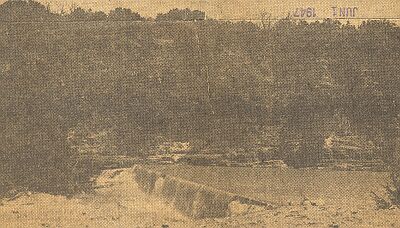 |
 |
 The
dam at Camp Billy Gibbons was built around 1945 and took only a couple
of months to build. Shown in the newspaper photo to your left is the dam
as it looked on June 1, 1947. Later, a flood on Brady Creek washed
the dirt out around the camp side of the dam. The dam had to be extended
and tied into the bluff on the camp side of the river. The
dam at Camp Billy Gibbons was built around 1945 and took only a couple
of months to build. Shown in the newspaper photo to your left is the dam
as it looked on June 1, 1947. Later, a flood on Brady Creek washed
the dirt out around the camp side of the dam. The dam had to be extended
and tied into the bluff on the camp side of the river.
According to Manley Webb, now deceased, when building the dam the builders used sand and gravel out of the river bed and mixed the material on site. The dam was built as cheaply as possible. The 21" drain pipe was laid first so the water in the river could drain through it while they worked on the dam. The pipe was laid in the bottom of the river bed and loose rock and gravel was "filled" over it to hold the pipe in place. Concrete was then poured over this "fill" as the dam was built. Water and Scouts, over fifty years, has washed out or taken out all the loose rock and material and has left a cavity in the dam approximately nine feet long, five feet deep and five feet high. This is the only place in the dam that this was done to our knowledge. Some of the pipe has rusted out too.
J. B. Boler, a member of the council board, was put in charge of the project to rebuild the dam. The cost of repairing and extending the dam was $1,950. By July 29, 1955, the excavation for the project was completed and the forms were being built for pouring of the cement. The dam was extended all the way to the rock bank and was completed the week of August 12, 1955. The contractor was paid in full on August 29. A special campaign was held to raise this emergency money. By the time they paid the contractor, they had raised $1,431. They had to borrow $519 from the bank to pay him completely. The dam is still holding today even though there has been as much as eight feet of water flowing over the dam during floods. The lake behind the dam has only been drained one other time. In the sixties (we think around 1966) the Otena Lodge worked in the dam, digging out gravel and sand for most of a day until they were able to locate the drain. The drain was covered at the time by a large rock. (We feel that the same rock is still at the end of the drain but not covering the whole drain at this time). They tied a rope around Rick Wilkins, an OA member, and he went under water and grabbed hold of the rock. Ten Arrowmen on the bank then bulled him and the rock loose from the drain. It took about two weeks to empty the lake according to those who were around then. They were suppose to get the Civil Engineers from Fort Hood to come up and dredge the river but were unable to work out a date. Eventually one of the leaders (name unknown) obtained a mattress from the Cook's cabin, stuffed it into the pipe and filled it up with rock to refill the lake. Looking inside the pipe from the lower end of the dam, it looks like he practically was able to roll the rock back over the drain before he stuffed the mattress and rocks into that part of the pipe that he was unable to cover with the rock. The lake has not been drained since then. In 1994,, while Burton Phillips was Otena Lodge Adviser, an attempt was made to once again drain the lake. Several work weekends were spent digging rock out from where they thought the drain pipe came out on the lake side of the dam. Due to the amount of silt in the river, they were unable to find the drain and unclog it. Fortunately, they were not successful, for the Soil Conservation Service told them that if the lake had been drained, the dam would have dried out in about two weeks. When the drain was then repulsed and water once again filled up behind the dam, it probably would have failed, due to the age of the concrete holding the rocks together. In other words, the dam would have come apart at the seams! The dam is eight feet high but the lake, in most places, is only four feet deep due to silting, except on the North side of the lake near the bluff (side opposite camp). There it is six to seven feet deep. Manley Webb, who was council President then, said that the lake bed slopes gradually from the camp side to the middle of the river and that it slopped rather steeply on the opposite side of the river near the bluff side. We want to thank Marc and Hilda Griffin for providing us with this story from papers that had in their personal archives. Last Updated: January
1, 2008
|